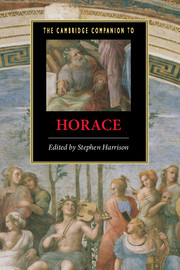Book contents
- Frontmatter
- Introduction
- Part 1: Orientations
- Part 2: Poetic Genres
- Part 3: Poetic Themes
- Part 4: Receptions
- 20 Ancient receptions of Horace
- 21 The reception of Horace in the Middle Ages
- 22 The reception of Horace in the Renaissance
- 23 The reception of Horace in the seventeenth and eighteenth centuries
- 24 The reception of Horace in the nineteenth and twentieth centuries
- Dateline of works and major political events
- Works cited
- Index
22 - The reception of Horace in the Renaissance
from Part 4: - Receptions
Published online by Cambridge University Press: 28 May 2007
- Frontmatter
- Introduction
- Part 1: Orientations
- Part 2: Poetic Genres
- Part 3: Poetic Themes
- Part 4: Receptions
- 20 Ancient receptions of Horace
- 21 The reception of Horace in the Middle Ages
- 22 The reception of Horace in the Renaissance
- 23 The reception of Horace in the seventeenth and eighteenth centuries
- 24 The reception of Horace in the nineteenth and twentieth centuries
- Dateline of works and major political events
- Works cited
- Index
Summary
Introduction: Petrarch to Jonson
Nothing prepares us for Petrarch’s conversation with Horace. It is not just a matter of quotations, adaptations or echoes. He creates a Horatian self-portrait - of a man with few needs and a gift for friendship, who does not seek social advancement, finds the city unpleasant and enjoys a life of withdrawal, but unlike Horace is a Christian and a tormented lover. And nothing in Horace anticipates Petrarch’s drastic comparison of reading Horace (and other favoured writers) with the process of digestion or with roots penetrating his marrow (Familiares 22.2.12-13).
One of the constants in the reception of Horace had been, and would long continue to be, the importance of the Ars Poetica, which during the sixteenth century was joined as a canonical text by Aristotle’s Poetics. Milestones marking developments in that reception are few between Petrarch’s death in 1374 and the 1460s. Perotti’s treatise on the metres of Horace and Boethius was written in 1453, and during the following decade there were courses of lectures in Florence, Rome and Verona. Horace was first printed around 1470, as was Perotti’s handbook. The ancient commentaries followed and, in 1482, a contemporary one by Landino. Also in the 1480s Politian lectured on Horace in Florence.
- Type
- Chapter
- Information
- The Cambridge Companion to Horace , pp. 305 - 317Publisher: Cambridge University PressPrint publication year: 2007
- 7
- Cited by

